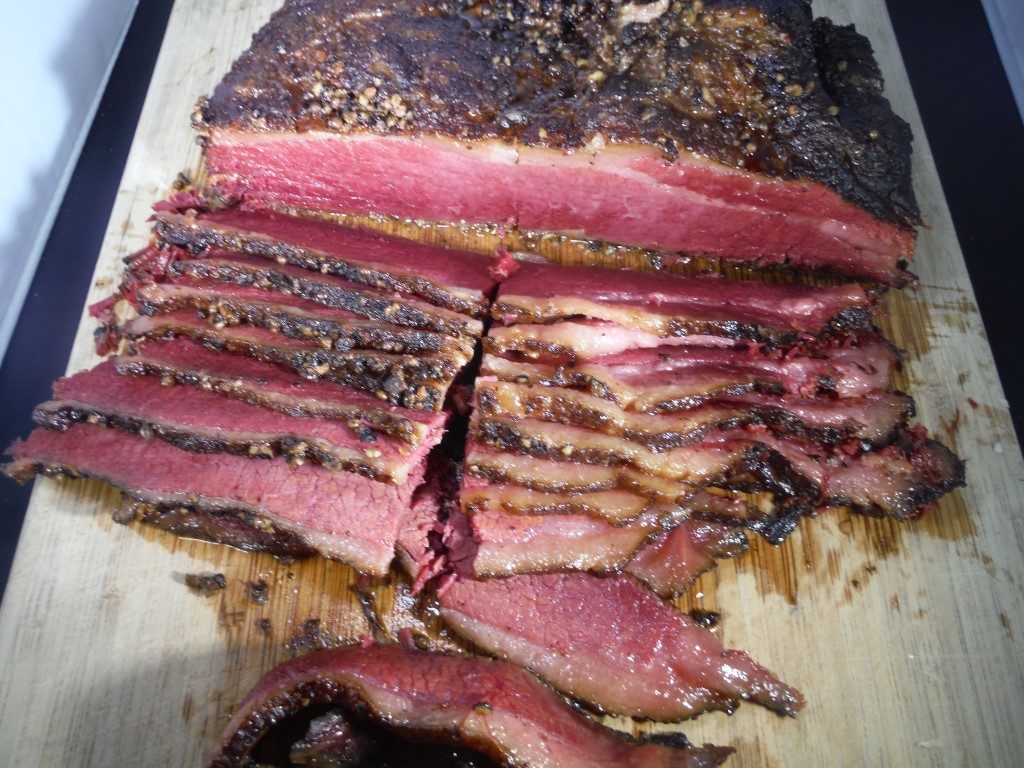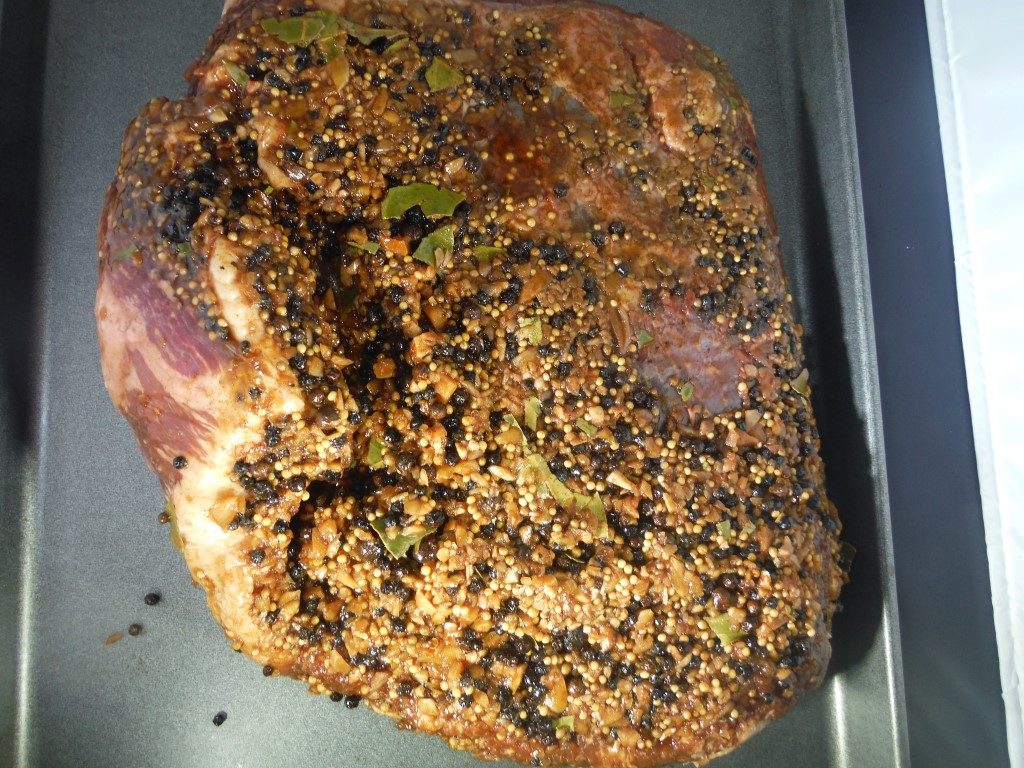Smoked Meat is Montreal’s answer to American pastrami. I had it for the first time when I was a college student and debated at McGill University. After Ben’s wedding in Albany, I went to Montreal a second time and had a smoked meat sandwich at Schwartz’s deli after waiting in a long line. A few year’s ago I bought The Mile End Cookbook, which is from a Montreal-style Jewish restaurant in Brooklyn, because it has a recipe for making smoked meat. It took a long time for me to get around to it, but I made a batch over the last two weeks, and it did turn out very well. It is an example of a dish which is not really hard to make, but which takes time, and is easier with the right equipment, like an electric box smoker and a large pot with a steamer liner. It takes about 12 days to cure the meat, 4 hours to soak it after the cure, 6-8 hours to smoke it, and then another 2 hours or so to steam it, and then the final product is ready. So it is a project, and takes a lot of elapsed time, but none of the steps are very difficult. The result was very tasty, and unlike anything I could get in Richmond.
According to Wikipedia, the Montreal Seasoning sold in the spice section is based on the spices used to make Smoked Meat.
12-15 lb. whole beef brisket
Curing Mixture
¾ cup plus 2 Tbs. Diamond Crystal kosher salt
1 Tbs. plus 2 tsp. pink curing salt
½ cup sugar
1 lb. peeled garlic (8-10 heads), coarsely chopped in a food processor
1 cup whole black peppercorns
6 Tbs. coriander seeds
¼ cup mustard seeds
2 Tbs. whole allspice berries, cracked
3 Tbs. dehydrated onions
3 Tbs. paprika
20 dried bay leaves
Spice Rub
¼ cup whole black peppercorns, cracked
2 Tbs. coriander seeds
1 Tbs. paprika
Trim the fat cap on the brisket to ¼ inch thick. Cut the brisket into two equal pieces so that each piece can fit in a 2.5 gallon ziplock baggie.
Mix all of the curing ingredients into a large bowl. (There is a lot of garlic and spices in this mixture.) Rub the brisket all over with the curing mixture. Put each half of the brisket into a 2.5 gallon ziplock baggie, express all the air out of the baggie, lay the pieces flat in a refrigerator. Flip the meat daily, and allow it to cure for 12 days. There is no harm if your schedule (like weekends) makes it more convenient to continue the curing process for another couple of days. The curing mixture is quite pungent, and after a few days I put the two baggies in a trash bag to try to reduce leakage of the smell into the rest of the refrigerator.
Here is what the meat looks like after it is cured:
When the brisket is cured, rinse the spices off under cold running water. Put the brisket in a non-reactive container (like the polycarbonate container I use for sous-vide cooking) and soak it in cold water for 4 hours on the kitchen counter to moderate the salt content. Dry the brisket with paper towels, and rub with the spice rub. Put the rubbed briskets on a rack and under a fan to dry the surface while the smoker is made ready.
Heat the smoker to 215 degrees, and smoke the briskets for 6-8 hours, with new chips every hour, until the internal temperature reaches 155 degrees.
Remove the smoked brisket, and store overnight and unwrapped on a cookie sheet in a refrigerator.
The next day, put the briskets in a steamer, and steam them for 1.5 to 2 hours until the meat is fork tender. Replenish the water periodically if necessary. Cut the steamed meat against the grain into ¼ inch slices and enjoy.





Thank you for detailing the process. As a transplanted Montrealer now living in California, I’m curious on what you referenced to determine the make up of the; cure, rub, and wood selection?
Well done!
Thanks for the positive comment. The curing mixture and spice rub are detailed in the recipe. I used hickory wood for smoking in a Masterbuilt electric box smoker. Did I answer your questions? As stated in the post, making smoked meat is not hard, but there is a lot of elapsed time (about two weeks) and a number of steps. For this reason, I would recommend making a big batch, portioning it, and freezing most of it.
Thanks, my question was more directed towards references you used to support your approach listed above – for example, what wood type was traditionally used to smoke the brisket? Maple, Oak, other? How certain are you that this is / was the traditional approach used to prepare the briskets? Similar for dry brine, rub & process.
Btw – no question that your recipe detailed above will result in a delicious representation of this style.
Thx
I followed pretty closely the recipe in The Mile End Cookbook. I notice that they use “oak or other hardwoods” while I probably used hickory, since it is the easiest to get.
If you want to try another smoked meat project, I have really liked making cottage bacon. (The recipe is on the blog. I just enjoyed some for breakfast this morning.) I like using pork butts or shoulders instead of bellies to make bacon because they have a good meat to fat ratio. For both the smoked meat and the bacon, a slice machine and a vacuum sealer are very helpful